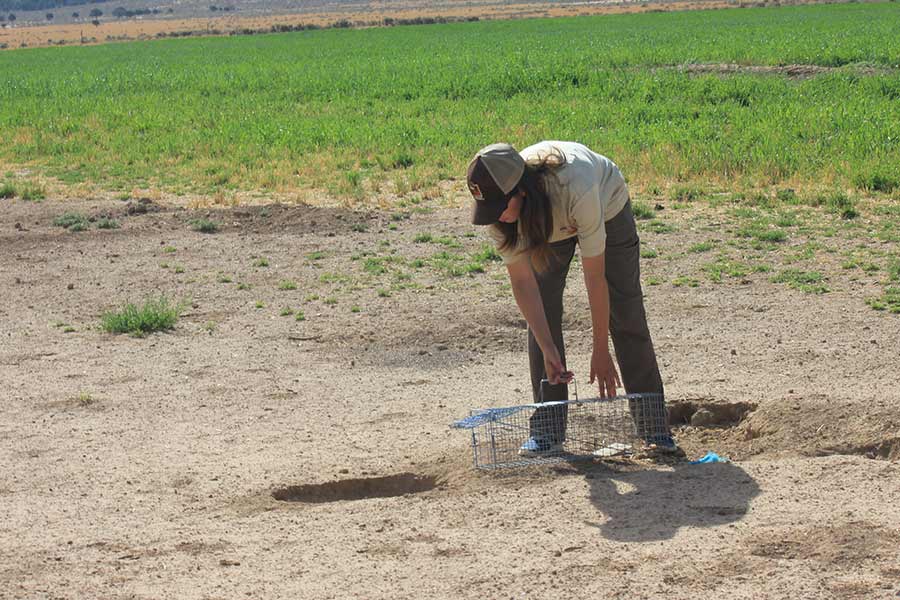≡
Utah prairie dog trapping and translocation
How trapping works and how to qualify
One of the primary strategies for recovering and delisting the Utah prairie dog is removing the animals from private lands — typically via trapping — and then releasing them into public and protected areas. (This process is called translocation.) The Utah Division of Wildlife Resources recognizes the importance of reducing conflicts associated with Utah prairie dogs, while still ensuring conservation of the species.
Translocation effectiveness has improved throughout the years and now plays an important role in Utah prairie dog recovery. Translocations can result in:
- The creation of new colonies
- Re-establishment of previously occupied colonies
- Support for existing colonies
- Improved gene flow and connectivity
All of the above will contribute to the recovery of the species and also help to address any development impacts.
Utah prairie dog trapping is provided by the DWR at no cost. Trapping is only provided during the prairie dog translocation season, which may differ, depending on your location. The two current translocation seasons are as follows:
- Iron County: July 1–Sept. 30
- Garfield County: July 1–Aug. 31
Trapping for development
Translocation of Utah prairie dogs helps remove them from development sites where they may be killed or injured by construction. Development trapping can help to prevent prairie dogs on the property from moving to another portion of the property, onto neighboring properties, or back onto the property after construction ends. A Utah prairie dog development survey and certificate of inclusion (permit obtained by paying a mitigation fee) are required before Utah prairie dogs may be trapped and/or translocated for development.
Utah prairie dog clearance request form
Trapping for agricultural control
Trapping is also available for agricultural properties that have a valid certificate of registration under the USFWS Special 4(d) Rule. Trapping can be used in place of — or in conjunction with — lethal control to help reduce the impacts of Utah prairie dogs on agricultural lands.
It is recommended that non-lethal trapping is used before lethal control, as prairie dogs may become more trap shy after the use of lethal methods. Please contact the DWR for more information on trapping for agricultural control.
Trapping independent of development
Under the 2018 General Conservation Plan (GCP), the DWR is allowed to trap and remove Utah prairie dogs from properties that are not associated with current development projects, but which will likely be impacted in the future. If a landowner has properties they anticipate developing in two or more years, then trapping independent of development may be a worthwhile investment.
Translocations independent of development apply only to private lands in major development areas. (These are rapidly developing areas where prairie dogs are most likely to be lost or where habitats will be fragmented.)
If no prairie dogs remain on the property after a two-year period (from the date the translocations independent of development occurred), the property can be cleared without mitigation. If prairie dogs remain on the property after the two-year period, development must follow the minimization and mitigation requirements of the GCP for any remaining Utah prairie dogs.
Important: Translocations independent of development do not necessarily remove mitigation requirements from developable properties. These properties are still considered occupied by prairie dogs for two years following translocation, even if no prairie dogs remain on the property after translocation. Development within that two-year period would require, under federal regulations, the landowner to obtain a permit and pay a mitigation fee before developing the property, even if no Utah prairie dogs remain.
Trapping for human health and safety
Under the federal Revised Special 4(d) Rule, Utah prairie dog trapping is allowed in areas where the animals present a credible, serious human safety hazard. (This type of trapping may only occur with the written approval of the U.S. Fish and Wildlife Service.) Areas of serious human safety concern do not include public rangelands or properties being developed for residential, commercial or transportation uses.
Note: There is no timing restriction on trapping or translocation for areas where prairie dogs are creating serious human safety hazards.









